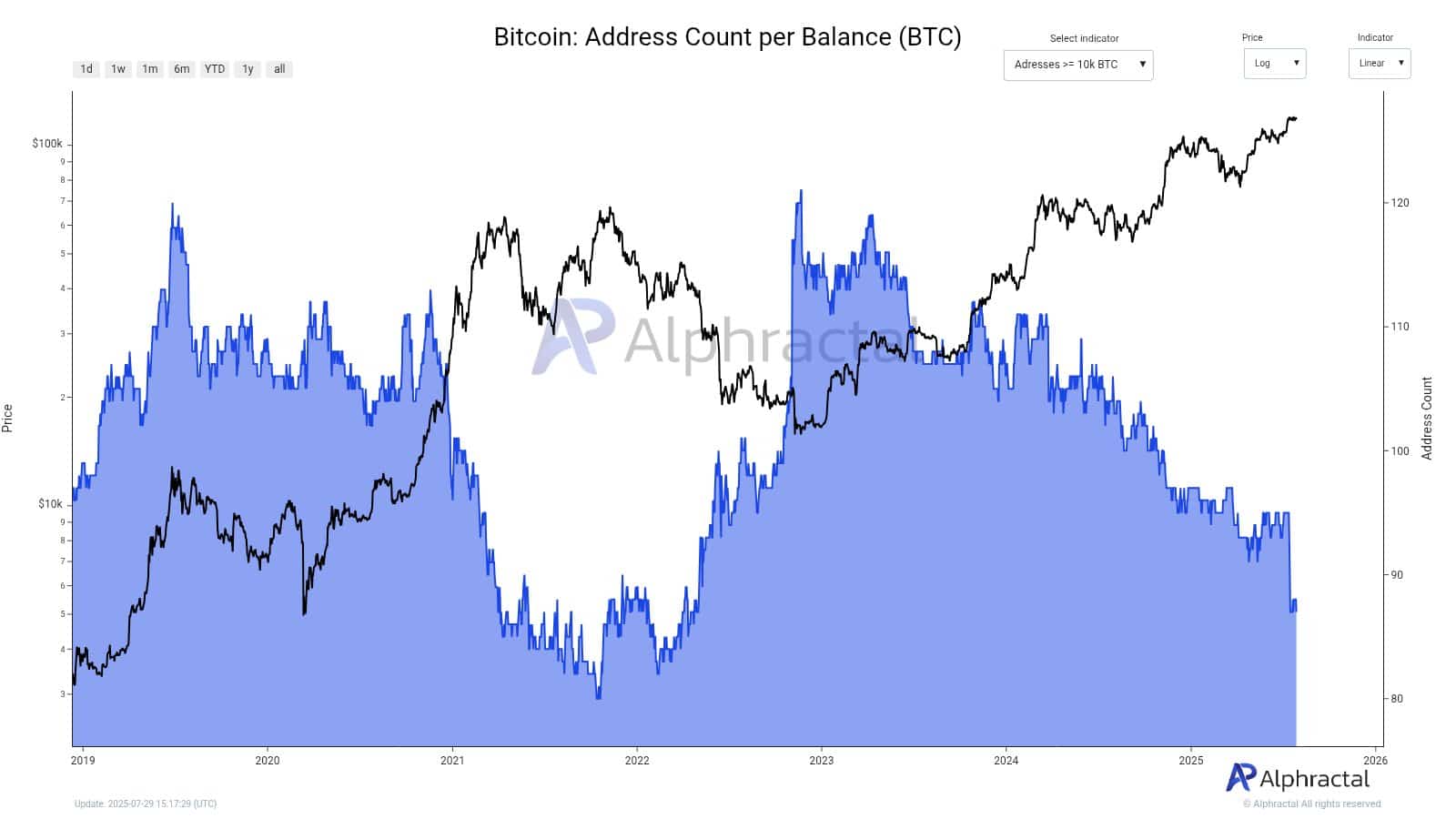Bitcoin’s price is rising even as the number of large whale wallets declines, driven by strong institutional buying and ETF inflows, indicating sustained market momentum despite bearish fractal signals.
-
Bitcoin price climbs while whale wallet count drops, mirroring 2021 market patterns.
-
Public companies like MicroStrategy and Mara Holding continue significant Bitcoin acquisitions, boosting institutional demand.
-
Bitcoin spot ETFs hold $151.28 billion in assets, maintaining bullish inflows that may counter fractal-based bearish forecasts.
Bitcoin price rises amid falling whale wallets and strong institutional buying. Stay informed with COINOTAG’s latest crypto insights.
What is driving Bitcoin’s price increase despite fewer whale wallets?
Bitcoin’s price is rising even as the number of wallets holding over 10,000 BTC decreases. On-chain data from Alphractal reveals a divergence where price climbs while large-holding addresses drop below 90, a pattern similar to the 2020–2021 bull market peak. This raises questions about the sustainability of the current cycle.
How are public companies influencing Bitcoin’s market dynamics?
Public companies remain active buyers, with MicroStrategy increasing its Bitcoin holdings by $2.46 billion through convertible notes, raising its portfolio to $74.18 billion. Mara Holding also added $950 million worth of Bitcoin recently. Collectively, 42 public firms now hold 4.28% of Bitcoin’s supply, with MicroStrategy alone controlling nearly 2.9%, signaling strong institutional confidence.

Source: Alphractal
Why do Bitcoin ETFs continue to support bullish momentum?
Bitcoin spot ETFs maintain strong inflows, with assets under management reaching $151.28 billion, according to CoinGlass data. In July alone, $4.83 billion worth of Bitcoin was purchased compared to $541.6 million sold. This robust buying activity from traditional finance channels may soften any potential market corrections projected by fractal analyses.

Source: CoinGlass
| Metric | Value | Comparison |
|---|---|---|
| Whale Wallets (>10,000 BTC) | Below 90 | Down from 2021 peak |
| MicroStrategy Bitcoin Holdings | $74.18 Billion | 60% increase recently |
| Bitcoin Spot ETF AUM | $151.28 Billion | Strong inflows in July |
What are expert projections for Bitcoin’s near-term outlook?
Bitcoin’s current bull market may be nearing its end, according to Alphractal analyst Joao Wedson, who forecasts a cycle conclusion by October. However, ongoing institutional buying and ETF inflows suggest momentum could persist beyond fractal-based bearish models, potentially leading to a shallow market pullback rather than a sharp reversal.
How does institutional sentiment impact Bitcoin’s price resilience?
Institutional confidence, demonstrated by public companies’ aggressive Bitcoin acquisitions and sustained ETF inflows, underpins price stability. This sentiment counters the declining whale wallet trend and supports a bullish narrative despite technical concerns, highlighting the complex dynamics shaping Bitcoin’s market trajectory.
Frequently Asked Questions
What does the decline in whale wallets mean for Bitcoin?
The decline in whale wallets suggests some large holders are reducing their Bitcoin positions. However, this is balanced by increased institutional buying and ETF inflows, which help maintain price strength.
How does institutional buying affect Bitcoin’s price stability?
Institutional buying provides significant liquidity and confidence in the market, supporting Bitcoin’s price and reducing volatility despite other bearish indicators.
Key Takeaways
- Bitcoin price is rising despite a decline in large whale wallets: This divergence mirrors patterns seen before the 2021 market peak.
- Public companies continue to accumulate Bitcoin: MicroStrategy and Mara Holding have significantly increased their holdings, signaling strong institutional demand.
- Bitcoin spot ETFs maintain bullish inflows: With $151.28 billion in assets, ETFs contribute to sustained market momentum.
Conclusion
Bitcoin’s price resilience amid declining whale wallets highlights a complex market influenced by strong institutional buying and ETF inflows. While fractal analysis suggests a possible cycle end by October, ongoing demand from public companies and ETFs may extend momentum, indicating a potential shallow correction rather than a sharp downturn. COINOTAG will continue monitoring these trends to provide timely insights.
